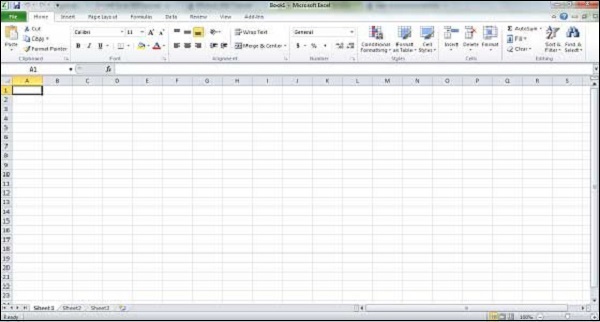Ms Office Excel
Introduction to Microsoft Excel
Microsoft Excel is a
commercial spreadsheet application, written and distributed by Microsoft for
Microsoft Windows and Mac OS X. At the time of writing this tutorial the
Microsoft excel version was 2010 for Microsoft Windows and 2011 for Mac OS X.
Microsoft Excel is a
spreadsheet tool capable of performing calculations, analyzing data and
integrating information from different programs.
By default, documents
saved in Excel 2010 are saved with the .xlsx extension whereas the file
extension of the prior Excel versions are .xls.
Ms Word Tutorial
This is a full and free
computer course for Microsoft Excel 2007 to 2016. It is designed for complete
beginners
Get Started with Microsoft Word
This chapter teaches you how to start an excel 2010 application in
simple steps. Assuming you have Microsoft Office 2010 installed in your PC,
start the excel application following the below mentioned steps in your PC.
Step 1 − Click on
the Start button.

Step 2 − Click on All
Programs option from the menu.

Step 3 − Search for Microsoft
Office from the sub menu and click it.

Step 4 − Search for Microsoft
Excel 2010 from the submenu and click it.

This will launch the Microsoft Excel 2010 application and you will
see the following excel window.

Excel Environment
Working with Workbook and Worksheet
Entering data
Formatting
Editing spreadsheets
Formulas and Functions
10 excel formulas you
should know about:
- SUM - Formula: =SUM(5, 5) or =SUM(A1, B1) or =SUM(A1:B5)The SUM formula does exactly what you would expect. It allows you to add 2 or more numbers together. You can use cell references as well in this formula.The above shows you different examples. You can have numbers in there separated by commas and it will add them together for you, you can have cell references and as long as there are numbers in those cells it will add them together for you, or you can have a range of cells with a colon in between the 2 cells, and it will add the numbers in all the cells in the range.
- COUNT - Formula: =COUNT(A1:A10). The count formula counts the number of cells in a range that have numbers in them.
This formula only works with numbers though:
It only counts the cells where there are numbers.
- COUNTA - Formula: =COUNTA(A1:A10) Counts the number of non-empty cells in a range. It will count cells that have numbers and/or any other characters in them. The COUNTA Formula works with all data.
It counts the number of non-empty
cells no matter the data type.
- LEN - Formula: =LEN(A1) The LEN formula counts the number of characters in a cell. Be careful though! This includes spaces. Notice the difference in the formula results: 10 characters without spaces in between the words, 12 with spaces between the words.

- TRIM - Formula: =TRIM(A1) Gets rid of any space in a cell, except for single spaces between words. I’ve found this formula to be extremely useful because I’ve often run into situations where you pull data from a database and for some reason extra spaces are put in behind or in front of legitimate data. This can wreak havoc if you are trying to compare using IF statements or VLOOKUP’s.

I added in an extra
space behind “I Love Excel”. The TRIM formula removes that extra space. Check
out the character count difference with and without the TRIM formula.
- RIGHT, LEFT, MID - Formulas: = RIGHT(text, number of characters), =LEFT(text, number of characters), =MID(text, start number, number of characters).(Note: In all of these formulas, wherever it says “text” you can use a cell reference as well) These formulas return the specified number of characters from a text string. RIGHT gives you the number of characters from the right of the text string, LEFT gives you the number of characters from the left, and MID gives you the specified number of characters from the middle of the word. You tell the MID formula where to start with the start_number and then it grabs the specified number of characters to the right of the start_number.
I used the MID formula to get the middle word. I had it look in cell A1, start at character 3, and grab 5 characters after that. This gives us just the word “love” from “I love Excel”
I used the RIGHT formula to get the last word. I had it look at cell A1 and grab the first 6 characters from the right. This gives us “Excel” from “I love Excel”
- VLOOKUP - Formula: =VLOOKUP(lookup_value, table_array, col_index_num, range_lookup) By far my most used formula. The official description of what it does: “Looks for a value in the leftmost column of a table, and then returns a value in the same row from a column you specify…”. Basically, you define a value (the lookup_value) for the formula to look for. It looks for this value in the leftmost column of a table (the table_array). Note: If at all possible use a number for the lookup_value. This makes it a lot easier to make sure the data you are getting back is a correct match. If it finds a match of the “lookup_value” in the left column of the “table_array” it will return the value in the column you specify using the “index_num”. The “index_num” is relative to the left most column. So, if you have the table_index look in column A and you want what is returned to be what’s in column B the “index_num” would be 2 because the leftmost column, column A in this case, is the 1st column in the table array and column B is the 2nd column (hence the 2 for the index number). If you want what is in column C to be returned you’d put 3 for the index_num. The “range_lookup” is a TRUE or FALSE value. If you put TRUE it will give you the closest match. If you put FALSE it will only give you an exact match. I only use FALSE when using the VLOOKUP formula.
The first list goes from A1
to B13. The 2nd list goes from D1 to E25. In cell C1 I would put the
formula =VLOOKUP(B18, $A$1:$B$13, 2, FALSE). B18 = the lookup_value (the
sales person’s ID. This is a number that appears on both lists.). $A$1:$B$13
= the “table_array”. This is the area I want the formula to search the leftmost
column (column E in this case) for the “lookup_value”. I went to F because if
it finds match in column E, I want it to return what’s in
column F. (The money signs are there so that the table_array will stay the same
no matter where the formula is moved or copied to. This is called an absolute
reference.). 2 = the index_num. This
tells the formula the number of columns away from the left most column to return in case of match. So, if you find a match between the lookup_value and
the leftmost column of the table array, return what’s in the same row in the
2nd column of the table (the 1st column is always the leftmost column. It
starts at 1, not 0). FALSE= tells the formula I
want it to only return the value if it’s an exact match. I would then copy and paste
that formula along all the cells in column C next to the first list. This would
give me a perfectly aligned list with the sales person’s ID, sales person’s
revenue for the quarter, and the sales person’s name.
In order to get a nice neat
list of Sales Person ID, Sales Person Name, and Sales Person Revenue all next
to each other I used the VLOOKUP formula to compare 1 list to another.
- IF Statements - Formula: =IF(logical_statement, return this if logical statement is true, return this if logical statement is false) When you’re doing an analysis of a lot of data in Excel there are a lot of scenarios you could be trying to discover and the data has to react differently based on a different situation. Continuing with the sales example: Let’s say a salesperson has a quota to meet. You used VLOOKUP to put the revenue next to the name. Now you can use an IF statement that says: “IF the salesperson met their quota, say “Met quota”, if not say “Did not meet quota” (Tip: saying it in a statement like this can make it a lot easier to create the formula, especially when you get to more complicated things like Nested IF Statements in Excel). It would look like this: In the example with the VLOOKUP we had the revenue in column B and the person’s name in column C (brought in with the VLOOKUP). We could put their quota in column D and then we’d put the following formula in cell E1:
This IF statement will tell us if the first salesperson met their quota or not. We would then copy and paste this formula along all the entries in the list. It would change for each sales person.
Having the result right there from the IF statement is a lot easier than manually figuring this out.
- SUMIF, COUNTIF, AVERAGEIF- Formulas: =SUMIF(range, criteria, sum_range), =COUNTIF(range, criteria), =AVERAGEIF(range, criteria, average_range) These formulas all do their respective functions (SUM, COUNT, AVERAGE) IF the criteria are met. There are also the formulas: SUMIFS, COUNTIFS, AVERAGEIFS where they will do their respective functions based on multiple criteria you give the formula.
I use these formulas in our example to see the average revenue (AVERAGEIF) if a person met their quota, Total revenue (SUMIF) for the just the sales people who met their quota, and the count of sales people who met their quota (COUNTIF)
- CONCATENATE - A fancy word for combining data in 2 (or more) different cells into one cell. This can be done with the Concatenate excel formula or it can be done by simply putting the &symbol in between the two cells. If I have “Steve” in cell A1 and “Quatrani” in cell B1 I could put this formula: =A1&” “&B1 and it would give me “Steve Quatrani”. (The “ “ puts a space in between what you are combining with the &). I can use =concatenate(A1, “ “, B1) and it will give me the same thing: “Steve Quatrani”
Finding The Right Excel Formulas For The Job
There
are 316 built in
functions in Excel. You’re not going to sit there and memorize
what all of them
do (or at least I hope not!). Luckily Excel has a built in wizard that
helps you find the correct formula for what you’re looking to
do (if there is one). Click the “fx” next to the formula bar in Excel
This brings up a menu and in
there you can type in a description of what you are trying to do and it will
bring up the correct excel formula:I typed in “remove extra
spaces” and it returned the TRIM formula that we went over earlier.
Working with Charts
Sorting data and Querying data
Linking worksheets
Importing and Exporting data
For more tutorial about
Ms Excel visit Tutorials Point

No comments:
Post a Comment